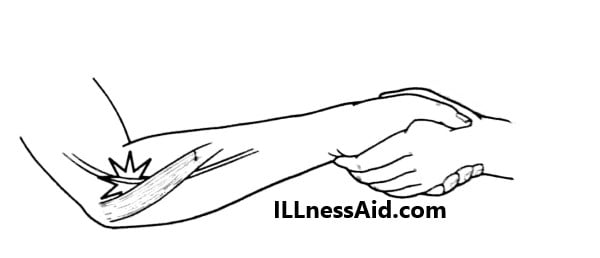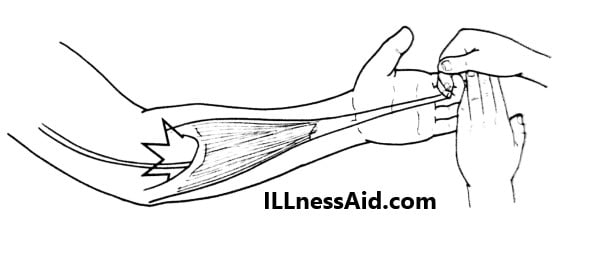Pronator syndrome is a less common condition. It is caused by median nerve entrapment in the proximal part of the forearm. Where the median nerve is compressed by pronator teres muscle, flexor superficialis arch, or lacertus fibrosus, this condition is known as “Pronator syndrome“. In this condition patient may feel abnormal sensations in the area:
- Thumb
- Index finger
- Ring finger
- The volar base of the thenar eminence

These area effects because of the involvement of the palmar cutaneous branch of the median nerve. There are more symptoms that show pronator syndrome-like:
- Proximal forearm tenderness
- Weakness in arm
- Fine motors are also effect
- Aching pain
EXAMINATION OF PRONATOR SYNDROME
We can examine a patient and confirm whether they have pronator syndrome or not by “Three provocative tests“. These three tests are divided according to the causes:
- Pronator teres test
- Lacertus fibrosus test
- Flexor digitorum superficialis test
PRONATOR TERES TEST
The most common cause of this syndrome is compression or entrapment of the median nerve by the pronator teres muscle. Which we can test by following these steps:
- Elbow should be flexed
- Hold the hand ( by the examiner)
- The resistance provided against pronation by the examiner

LACERTUS FIBROSUS TEST
This test is for the examine lacertus fibrosus(A fascial extension of the biceps tendon), It shows median nerve is entrapment by this. We can do this test by following these steps:
- Elbow should be slightly flexed with a supinated forearm
- Examiner will hold the supinated hand
- Resistance will provide against the elbow flexion by the examiner

FLEXOR DIGITORUM SUPERFICIALIS TEST
In this test, we examine the flexor digitorum superficialis muscle and identify whether it is the reason for this syndrome or not. This test has the following steps:
- Hold the forearm supinated with a slightly flexed elbow
- Examiner will hold the middle finger
- Resistance will provide against the middle finger flexion

TREATMENT FOR PRONATOR SYNDROME
NON OPERATIVE TREATMENT
We can manage this disorder by a lot of nonoperative management that includes:
- You should minimize the activities that resist pronation
- Avoid repetitively gripping and squeezing
- You can use a long arm splint with the elbow 90 degrees(flexion) and the forearm will be in a neutral position
- You can take anti-inflammatory medications and vitamin B (should consult your doctor before following this step)
NOTE: Above are the few conservative management of this disorder, But conservative management is often ineffective in this disorder, and operative treatment is usually required. So you should go to the doctor first and then follow conservative treatment.
AFTER OPERATIVE TREATMENT (REHABILITATION)
0-7 DAYS
- Should wear soft, light compressing dressing to allow full elbow, forearm, and wrist motion
7 DAYS
- Should start activities that can tolerate
- Also begin range of motion of elbow, forearm, and wrist
2 WEEKS
- Remove the sutures
- Start progressive strengthening and use of the upper limbs
4 WEEKS
- You can allow moderate to heavy work
6 WEEKS
- You can use your full arm without protection
KNOWING THE PROBLEM, ALWAYS HELP TO SOLVE
ILLnessAid
Thank you for reading this far today we talk about pronator syndrome and its examination, treatment and more. If you have any doubts regarding this you can comment below or go on the contact us page.

